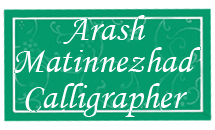Siah mashgh
Siyah mashq (Persian: ) lit. “black practice”, are calligraphic practice sheets often covered completely with writing. They may include a number of diagonal words and letters used in combinations facing upwards and downwards on the folio. Siyah mashq was originally just a practice for the calligrapher to warm up his hand and to refine the shape of letters by repeating them over and over. These practices resulted in a page filled with words and letters. When calligraphers realised how stunning some of these pieces were it was turned into a style of its own. Words and letters are repeated regardless of meaning, all for the sake of composition and style.
As an established genre, practice sheets abide to certain rules of formal compositions, largely guided by rhythm and repetition. Although siyah mashq sheets survive from ca. 1600, they seem to have been a particularly popular genre during the second half of the 19th century, i.e., during the artistic revival spearheaded by the Qajar ruler Nasir al-Din Shah, who reigned from 1848 to 1896.
Before the advent of Islam, Iranians used cuneiform, Pahlavi, and avestan alphabets. The Arabic alphabet that was in use two centuries before Islam, was Kufi, which continued in it’s simple form for another two centuries, until an Iraninan minister ( Bayzavi Shirazi) to the caliph, produced six different shapes with twelve rules and from then on, the Arabic Kufi was transformed and evolved into different modes of writing. Several steps were taken by Persian Hassan who created ta’lique , Ali Tabrizi who combined ta’lique with naskh and created nasta’lique. Several dozen Iranian artists added their touch and calligraphy was shaped into the art it is today.
